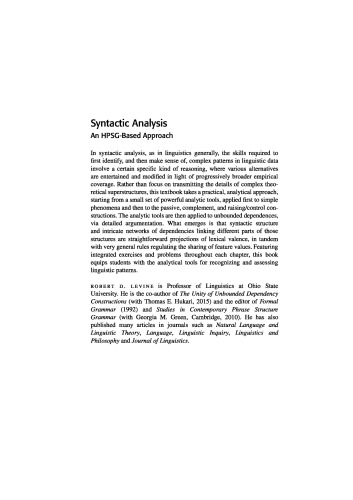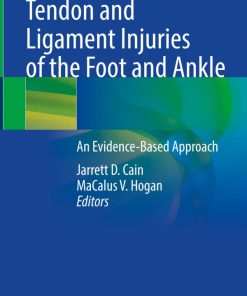Syntactic Analysis An HPSG Based Approach 1st Edition by Robert Levine ISBN 9781108105460 1108105467
$50.00 Original price was: $50.00.$25.00Current price is: $25.00.
Syntactic Analysis An HPSG Based Approach 1st Edition by Robert Levine – Ebook PDF Instant Download/Delivery: 9781108105460 ,1108105467
Full download Syntactic Analysis An HPSG Based Approach 1st Edition after payment
Product details:
ISBN 10: 1108105467
ISBN 13: 9781108105460
Author: Robert Levine
Syntactic Analysis An HPSG Based Approach 1st Edition Table of contents:
1 Syntactic Data, Patterns, and Structure
1.1 Introduction: The Problem, and a Possible Solution
1.1.1 Natural Language Data
1.1.2 A Possible Line of Solution
1.2 Structure: Some Clues
1.2.1 Displacement: A Basic Natural Language Pattern
1.2.2 VP Proform Replacement
1.3 Labeling Phrasal Categories: Why VP?
1.4 Subconstituents of VP
1.4.1 Evidence for NPs
1.4.2 Versions of the Displacement Test
1.4.3 Evidence for PP
1.5 Tree Representation of Constituent Structure
1.6 A Worked Example: Solution Procedure
1.7 Trees and Grammars: A Preview
1.8 What Comes Next?
2 Syntactic Rules and Lexical Valence
2.1 The Setting
2.2 Where Do Syntactic Structures Come From?
2.2.1 Phrase Structure Rules, Continued
2.3 The Valence Problem
2.4 The Valence Solution
2.5 Refinements
2.6 Subject Selection
2.7 NPs
2.7.1 One Replacement
2.7.2 Generalizing the NP System
2.8 Adjuncts
2.9 Markers
2.10 A Unitary Architecture for Syntactic Categories?
2.11 What Comes Next?
3 The Auxiliary Dependency
3.1 Auxiliary Phenomena: What Are Auxiliaries?
3.1.1 The NICE Properties
3.1.2 The Auxiliary System Dependency
3.1.3 How Modals Reveal Themselves to Be Verbs
3.2 What Is the Phrase Structure of Clauses with Auxiliaries?
3.2.1 Auxiliaries as VP Heads?
3.2.2 Coordination
3.2.3 Null Subjects: An Alternative That Doesn’t Work
3.3 Capturing Auxiliaries
3.3.1 Some Stocktaking
3.3.2 Solving the Auxiliary Puzzle Via Valence
3.3.3 Capturing Auxiliary Ordering
3.4 Auxiliaries and Subject Selection
3.5 Where Does Inversion Come From?
3.6 What Comes Next?
4 Local Dependencies and Lexical Rules
4.1 Case and Agreement
4.1.1 Case
4.1.2 Agreement
4.2 Passive
4.2.1 The Basic Cases
4.2.2 Passive Imposters
4.3 Infinitival Complements
4.4 Extraposition
4.4.1 Basic Data
4.4.2 Phrase Structure of the Extraposition VP
4.5 There
4.5.1 Basic Data
4.5.2 There Is a Subject
4.5.3 There Is a (Pronominal) NP
4.5.4 There VPs Immediately Dominate the Predicate
4.5.5 Accounting for There
4.6 Ergative and Antipassive
4.7 What Comes Next?
5 Infinitival Complements
5.1 Consequences of the V NP VP Analysis
5.2 What Is Infinitival to?
5.2.1 To as a Preposition?
5.2.2 To as a Complementizer?
5.2.3 NICE Revisited
5.3 Raising Verbs, Continued
5.4 ‘Super-Raising’: The French Tense Auxiliaries
5.5 What Comes Next?
6 The Limits of Valence: Topicalization
6.1 Beyond Valence: Data
6.2 Beyond Valence: Structure
6.3 Beyond Valence: Mechanism
6.3.1 Is Constituent Structure Shared between Filler and Gap?
6.3.2 Filler/Gap Linkage Via SLASH
6.3.3 Connectivity via SLASH: The Complete Picture
6.3.4 Connectivity: A Case Study
6.4 Cross-linguistic Evidence for the Locality of Extraction
6.4.1 French
6.4.2 Irish
6.4.3 Icelandic
6.4.4 Yiddish
6.4.5 Welsh
6.5 What Comes Next?
7 Epilogue: Unbounded Dependencies and the Limits of Syntax
7.1 Extraction Constructions in English
7.1.1 Fillers in Topic Position
7.1.2 Fillers in Argument Positions
7.2 ‘Syntactic’ Restrictions on Filler/Gap Linkages: An Incomplete Survey
7.2.1 The Complex NP Constraint
7.2.2 Wh-Islands
7.2.3 That-Trace Effect
7.3 Rethinking the Status of ‘Syntactic’ Constraints
7.3.1 CNCP and Related Phenomena
7.3.2 The Coordinate Structure Constraint Reexamined
7.3.3 Where Does the That-Trace Effect Come from?
7.4 Conclusion: The Limits of Syntactic Explanation
Suggestions for Further Reading
References
Index
People also search for Syntactic Analysis An HPSG Based Approach 1st Edition:
syntactic based approach
what is syntactic variation
syntactic units psychology
hpsg textbook
model syntactic structure
Tags: Robert Levine, Syntactic Analysis, HPSG, Approach
You may also like…
Mathematics - Analysis
An Introduction to Analysis 1st Edition by Robert C Gunning ISBN 0691178798 9780691178790
Business & Economics - Management & Leadership
Organizational Behavior An Evidence Based Approach 14th Edition Fred Luthans
Psychology - Clinical Psychology
Parental Alienation An Evidence Based Approach 1st Edition Denise Mccartan
Engineering - Civil & Structural Engineering
An Introduction to Geotechnical Engineering 3rd Edition Robert D. Holtz












